Night sky, May 2024: What you can see tonight [maps]
Find out what's up in your night sky during May 2024 and how to see it in this Space.com stargazing guide.


Looking for a telescope for the next night sky event? We recommend the Celestron Astro Fi 102 as the top pick in our best beginner's telescope guide.
The night sky tonight and on any clear night offers an ever-changing display of fascinating objects you can see, from stars and constellations to bright planets, the moon, and sometimes special events like meteor showers.
Observing the night sky can be done with no special equipment, although a sky map can be very useful, and a good telescope or binoculars will enhance some experiences and bring some otherwise invisible objects into view. You can also use astronomy accessories to make your observing easier, and use our Satellite Tracker page powered by N2YO.comto find out when and how to see the International Space Station and other satellites. We also have a helpful guide on how you can see and track a Starlink satellite train.
You can also capture the night sky by using any of the best cameras for astrophotography, along with a selection of the best lenses for astrophotography.
Read on to find out what's up in the night sky tonight (planets visible now, moon phases, observing highlights this month) plus other resources (skywatching terms, night sky observing tips and further reading)
Related: The brightest planets in May's night sky: How to see them (and when)
Monthly skywatching information is provided to Space.com by Chris Vaughan of Starry Night Education, the leader in space science curriculum solutions. Follow Starry Night on Twitter @StarryNightEdu and Chris at @Astrogeoguy
Editor's note: If you have an amazing skywatching photo and would like to share them with Space.com's readers, send your photo(s), comments, and your name and location to spacephotos@space.com.
Calendar of observing highlights
Wednesday, May 1: Third Quarter Moon
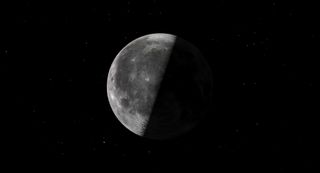
The moon will reach its third quarter phase on Wednesday, May 1 at 11:27 GMT, which converts to 7:27 a.m. EDT or 4:27 a.m. PDT. Third quarter moons rise around midnight in your local time zone and then linger into the southern sky after sunrise.
At third, or last, quarter, the moon's western half is illuminated by the pre-dawn sun and the pole-to-pole terminator line becomes a straight line. The week of dark, moonless evening skies that follow this phase will be ideal for observing deep sky targets in binoculars and telescopes, especially spring galaxies.
Friday, May 3: Crescent moon approaches Saturn and Mars (pre-dawn)
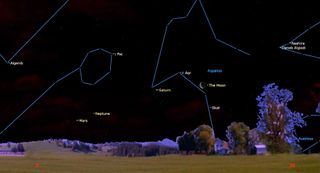
Early risers on Friday, May 3 can look above the eastern horizon for the pretty, waning crescent moon shining a palm's width to the right (or about 8 degrees to the celestial southwest) of Saturn's bright, yellowish dot. Reddish Mars will be positioned about 1.5 fist diameters to Saturn's lower left, and far fainter blue Neptune will be positioned between them.
Half a day later, skywatchers across most of Antarctica, southeastern Australasia, southwestern Polynesia, and southeastern Melanesia can watch the moon occult, or pass very close to, Saturn.
Saturday, May 4: Old moon nears Neptune and Mars (pre-dawn)

Before sunrise on Saturday morning, May 4, the waning crescent moon's cruise past the morning planets collected over the eastern horizon will continue. After 24 hours, the moon will shine midway between creamy-yellow Saturn and reddish Mars. Distant blue Neptune will be located between Mars and the moon, but that faint planet will be a challenge to see in the brightening sky.
Observers located closer to the tropics, where the ecliptic will be more vertical, will see the gathering more easily. Early on Sunday morning, skywatchers from southeastern Australia to New Zealand can use a telescope to see the moon occult Neptune.
Sunday, May 5: Old moon passes Mars (pre-dawn)
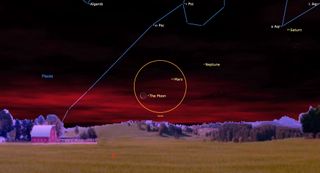
Another day of travel will shift the even slimmer crescent moon several finger-widths to the lower left (or 4 degrees to the celestial east) of Mars. In the Americas, the duo will be close enough to share the view in binoculars (orange circle) — but turn all optics away from the eastern horizon before the sun rises.
That same morning, observers from Madagascar to Sri Lanka, Southeast Asia, northwestern Indonesia, the Philippines, eastern China, Japan and the southeastern shore of Russia can watch the moon occult Mars. Use an app like Starry Night to look up the times for your location. The event will occur in daylight for the eastern portion of that zone.
Sunday, May 5: Eta-Aquarid meteor shower peak (overnight)
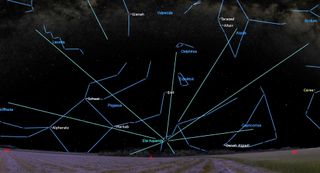
The annual Eta-Aquarids meteor shower is produced when Earth's orbit carries us through a cloud of particles left behind by repeated passages of Halley's Comet. The shower, which runs from April 19 to May 28, will peak in intensity on Sunday evening, May 5 in the Americas — with no moonlight to spoil the show.
While meteors should be visible on Sunday after dusk, more should appear once the shower's radiant point in Aquarius rises above the southeastern horizon around 3 a.m. local time on Monday. A few dozen meteors per hour are typical during the peak — including some fireball meteors. Its southerly radiant makes the Eta-Aquariids shower better for observers located closer to the tropics.
Monday, May 6: Sliver of moon and Mercury (before sunrise)

The moon will complete its monthly visit with the morning planets on Monday, May 6. Before sunrise, look just above the eastern horizon to see the very thin sliver of the moon positioned several finger-widths to the upper left (or 3 degrees to the celestial north) of Mercury.
The duo, which will be cozy enough to share the view in binoculars (orange circle), will rise by about 5 a.m. local time and remain in sight until the brightening sky hides them. Observers located closer to the tropics will see their meeting more easily.
Wednesday, May 8: The New Moon
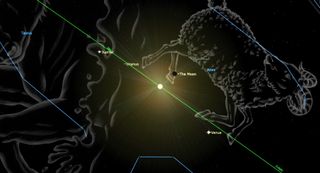
The moon will officially reach its new moon phase on Wednesday, May 8 at 03:22 GMT, which converts to 11:22 p.m. EDT, 8:22 p.m. PDT on Tuesday. At new, our natural satellite will be located between Venus and Jupiter in Aries, and less than 2 degrees north of the sun.
While at its new phase, the moon is traveling between Earth and the sun. Since sunlight can only shine on the far side of the moon, and the moon is in the same region of the sky as the sun, it becomes completely hidden from view from anywhere on Earth for about a day. After the new moon phase, Earth's natural satellite will return to shine as a very thin crescent in the western evening sky.
Friday, May 10: Mercury at greatest western elongation (before sunrise)

On Friday, May 10, Mercury (orbit shown in red) will reach its greatest angle (26.4 degrees) from the morning sun and maximum visibility for its current morning apparition. With Mercury positioned in the eastern sky and well below the tilted morning ecliptic (green line), this appearance of the innermost planet will be a poor one for Northern Hemisphere observers, but an excellent one for those viewing from the tropics and the Southern Hemisphere.
The optimal viewing times at mid-northern latitudes will start around 5:15 a.m. local time. Viewed in a telescope (inset) the planet will exhibit a waxing, almost half-illuminated phase.
Saturday, May 11: Mare Crisium (evening)
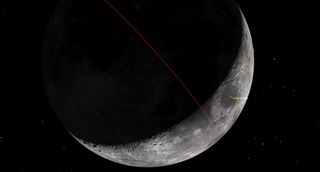
On Saturday evening, May 11, the pretty crescent of the young moon will host the dark oval of Mare Crisium. This 345-mile (556 km) diameter basin is easy to see using your unaided eyes, binoculars, and any telescope.
It is located near the eastern edge of the moon, just north of the moon's equator (the up-down red curve). The wobble of the moon, known as lunar libration, shifts Mare Crisium higher and lower, and closer and farther from the moon's edge at various times.
Sunday, May 12: Crescent moon aligns with Gemini's Twins (evening)
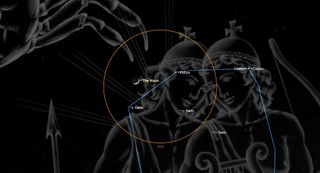
In the western sky on Sunday evening, May 12, the pretty, waxing crescent moon will align with Gemini's bright stars Pollux and Castor. Pollux, the brighter and more yellowish of the "twins", will be close enough to the right of the moon for them to share the view in binoculars (orange circle). The slightly fainter and whiter double star Castor will sparkle farther to their right (or celestial northwest).
The trio will set around 1 a.m. in your local time zone. For observers in more westerly time zones, the moon's orbital motion will carry it farther from Pollux.
Monday, May 13: Lunar craters Theophilus, Cyrillus, and Catharina (evening)
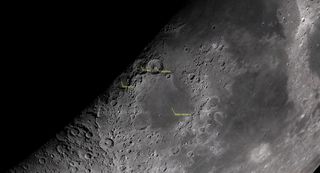
On Monday evening, May 13, the terminator boundary between the moon's lit and dark hemispheres will fall just to the left of a trio of large craters named Theophilus, Cyrillus, and Catharina that occupy the curved western edge of gray Mare Nectaris.
You can tell what order the craters were formed in by observing how sharp and fresh Theophilus' rim appears, and by how it has partially overprinted neighboring Cyrillus to its lower left (or lunar southwest).
Under magnification, Theophilus' terraced rim and craggy central mountain peak are evident. Cyrillus hosts a trio of degraded central peaks inside a hexagonal rim, while much older Catharina's peak has been submerged, her edges blurred and her floor overprinted by smaller, more recent craters.
Wednesday, May 15: First Quarter Moon
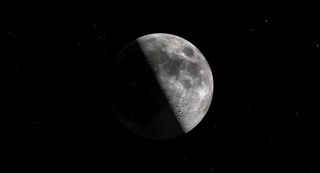
When the moon completes the first quarter of its orbit around Earth at 7:48 a.m. EDT, 4:48 a.m. PDT, or 11:48 GMT on Wednesday, May 15, the 90-degree angle formed by the Earth, sun, and moon will cause us to see our natural satellite half-illuminated — on its eastern side.
While at first quarter, the moon always rises around noon and sets around midnight, allowing us to see it in the afternoon daytime sky, too. The evenings surrounding the first quarter phase are the best ones for viewing the lunar terrain when it is dramatically lit by low-angled sunlight.
Thursday, May 16: Ceres stops cruising
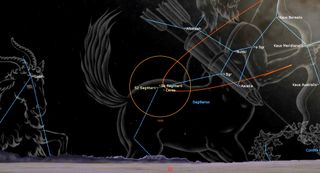
On Thursday, May 16, the minor planet Ceres, the largest object in the main asteroid belt, will cease its regular eastward motion across the background stars of Sagittarius and commence a westerly retrograde loop that will last until in late August (red path).
After the magnitude 8.3 object, which is visible in binoculars (orange circle) and backyard telescopes, rises around 12:30 a.m. local time, it can be located a fist's diameter to the left of Sagittarius' teapot asterism and less than a finger's width to the right (or 0.6 degrees to the celestial WSW) of the two medium-bright stars named 51 and 52 Sagittarii. After tonight Ceres will begin to travel towards the teapot.
Sunday, May 19: Pallas at opposition (all night)
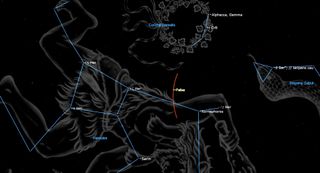
On Sunday, May 19, the main belt asteroid designated (2) Pallas will reach opposition, its closest approach to Earth for the year. On the nights around opposition, Pallas will shine with a peak visual magnitude of 9.1, which is within reach of a backyard telescope.
The asteroid will be located above and between the bright double star Zeta Herculis, which marks the upper right corner of Hercules' keystone-shaped body, and Kornephoros, which shines at Hercules' elbow. Pallas itself will spend May sliding downward (to the celestial south) between those stars. The asteroid and nearby stars will already be climbing the eastern sky after dusk and will spend the night crossing the sky together.
Sunday, May 19: Bright moon approaches Spica (overnight)

On Sunday afternoon, May 19, the pale orb of the waxing gibbous moon will clear the trees toward the southeast by about 5:30 p.m. local time. Once the sky darkens several hours later, Virgo's brightest star Spica will be visible to the lower right (or celestial southeast) of the very bright moon.
Binoculars (orange circle) will better show the star against the moon's glare. As the night unfolds the moon's continuous eastward orbital motion (green line) will be apparent as it changes its distance from Spica.
Thursday, May 23: Full Milk Moon
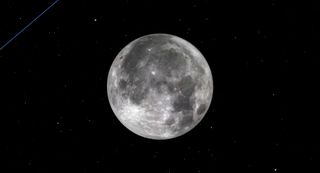
The moon will reach its full phase on Thursday, May 23 at 9:53 a.m. EDT, 6:53 a.m. PDT, or 13:53 GMT. In the Americas, the moon will appear to be full on both Wednesday and Thursday night, but closer inspection will reveal a strip of shadow curving along the moon's left and right limb, respectively, on those nights.
Full moons in May always shine in or near the stars of Libra or Scorpius. The indigenous Ojibwe groups of the Great Lakes region call the May full moon Zaagibagaa-giizis, the "Budding Moon" or Namebine-giizis, the "Sucker Moon". For them, it signifies a time when Mother Earth again provides healing medicines. The Cree of North America call it Athikipisim, the "Frog Moon" — the time when frogs become active in ponds and swamps. The Cherokee call it Ahnisguti, the "Planting Moon", when the fields are plowed and sown. Other common names are the Milk Moon, Flower Moon, or Corn Planting Moon.
Thursday, May 23: Bright moon brushes Antares (evening)
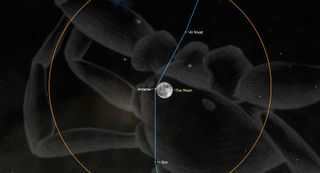
When the very bright and still rather full moon clears the rooftops to the southeast on Thursday evening, May 23 in the Americas, it will be shining very close to Scorpius' brightest star, reddish Antares.
Skywatchers located in southeastern North America, across northern and eastern South America, the Ascension Islands, and across the Atlantic to west central Africa will be able to watch the moon occult Antares through binoculars (orange circle) and backyard telescopes. The surrounding regions will see the moon pass very close to the star. Use an app like Starry Night to look up your own times for the event. In Miami, the moon will cover the star from 9:13 to 10:19 p.m. EDT.
Saturday, May 25: Catch the colors of stars (all night)
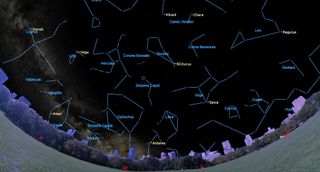
Stars shine with a color that is controlled by their surface (or photospheric) temperature, and this is captured in their spectral classification. The three bright stars of the eastern sky Summer Triangle asterism are climbing the eastern sky after dusk. Named Deneb, Vega, and Altair, they are A-class stars that appear blue-white to the eye and have temperatures in the range of 7,500 to 10,000 Kelvins.
Arcturus, which dominates the southern sky in evening, is an orange, K-class giant star with a temperature of only 4,300 K. Chara, the fainter of Canes Venatici's two stars, is a yellowish, G-class star with a temperature of 5,900 K, similar to our sun's. Reddish Antares, the heart of Scorpius and sparkling above the southern horizon, is an old M-class star with a low surface temperature of 3,500 K.
You can estimate the temperatures of fainter stars by comparing their color to these bright reference stars.
Sunday, May 26: The polar dragon (all night)
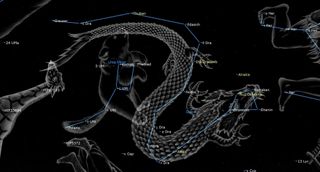
Draco, the Dragon was one of Greek astronomer Ptolemy's original 48 constellations and is circumpolar for mid-northern latitudes. Its sinuous body winds between the dippers.
The ring of four stars that form its head sits north of Hercules and the very bright star Vega. The dimmest of the head stars Kuma (Nu Draconis) is an easily split double star. Other notable double stars include magnitude 2.8 Eta Draconis (or Athebyne) and magnitude 5.5 Mu Draconis (or Alrakis).
The star Thuban was Earth's pole star for Ancient Egyptians and will again take a turn in AD 21,000. The northern polar axis of the sun (and of most of the planets in our solar system) points at the star Altais (Delta Draconis).
Tuesday, May 28: Berenices' Hair (all night)

The constellation of Coma Berenices, or Berenice's Hair, is composed of three medium-bright stars arranged as a right-angle triangle. In the evenings during late May, those stars are located high in the western sky, several fist diameters to the lower left of the Big Dipper and two fist diameters above (or 18 degrees to the celestial northeast of) Leo's bright tail star Denebola.
Beta Comae Berenices, the highest of the trio, is slightly brighter than the other two stars. Diadem shines to its lower left. The star Gamma Comae Berenices (or γ Com or Al Dafirah) to Beta's lower right is close to the limit of visibility in light polluted skies but is easy to see in rural locations.
The Coma Star Cluster is a collection of 4th and 5th magnitude stars sprinkled just below (to the celestial southwest of) Gamma. The large open cluster, spanning a palm's width (7 degrees) of the sky, is approximately 290 light-years distant. It is best viewed using binoculars.
The cluster is meant to represent the hair of Berenice. Other names for the cluster are Ariadne's Hair, Thisbe's Veil, the Cobweb Cluster, the Flying Witch, Black Bart's Hair, and Melotte 111. In antiquity, those stars represented the tuft at the end of Leo's tail.
Thursday, May 30: Third Quarter Moon again

When lunar phases occur on the first day or two of a calendar month, they can repeat at month-end. The moon will officially reach its third quarter phase at 1:13 p.m. EDT, 10:13 a.m. PDT, or 17:13 GMT on Thursday, May 30.
At third (or last) quarter the moon appears half-illuminated, on its western, sunward side. It will rise in the middle of the night, and then remain visible until it sets in the western daytime sky during late morning. Third quarter moons are positioned ahead of the Earth in our trip around the Sun. About 3½ hours later, Earth will occupy that same location in space. The week of dark, moonless evening skies that follow this phase are the best ones for observing deep sky targets.
Friday, May 31: Crescent moon crosses Saturn (pre-dawn)
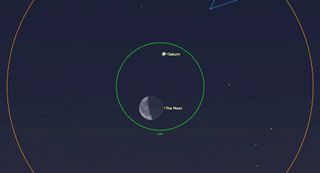
When the waning crescent moon rises in the southeast around 2 a.m. local time on Friday morning, May 31, it will be accompanied by Saturn.
The duo will be close enough to share the view in binoculars (orange circle) or a low power telescope (green circle). They'll climb higher and shift south until the brightening sky hides the ringed planet towards sunrise. Around 07:00 GMT, observers in southern South America and across the Atlantic to equatorial Africa can watch the moon occult Saturn with binoculars and backyard telescopes — albeit in the daytime for the eastern regions of the event path.
Friday, May 31: Bright Mercury near modest Uranus (pre-dawn)
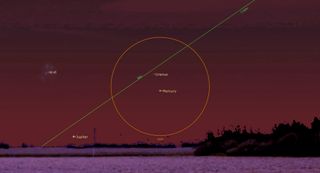
Before sunrise on Friday morning, May 31, look above the east-northeastern horizon for the bright dot of Mercury. Binoculars or a backyard telescope will reveal 440 times fainter Uranus positioned a thumb's width to Mercury's upper left (or 1.3 degrees to the celestial north).
The stars of the Pleiades cluster aka Messier 45 will be located a palm's width to the left of the two planets. Bright Jupiter will rise to join the party just before sunrise. Turn all optical aids away from the eastern horizon before the sun rises.
Visible planets in May
Mercury
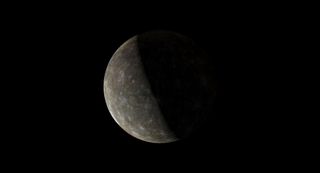
As May begins, Mercury will be extending its angle from the sun in the eastern pre-dawn sky. The planet will reach peak visibility while at its maximum angle of 26.4 degrees west of the sun on May 10.
That morning, the optimal viewing time for observers in the Northern Hemisphere will start around 5:15 a.m. local time. This appearance of Mercury will be so-so for mid-northern latitude observers, but the best one of the year for those in the tropics and farther south. The planet will grow brighter every morning during May, but it will become harder to see while it slowly returns sunward after mid-month.
Viewed in a telescope, Mercury's illuminated phase will wax from 27% to 80% and its apparent disk size will shrink from 9.57 to 5.66 arc-seconds. On May 6, the waning crescent moon will be positioned several finger-widths to the upper left (or 3 degrees to the celestial north) of Mercury. The planet will end May approaching Jupiter.
Venus
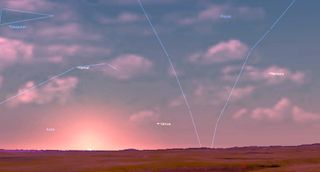
During May, Venus will be too close to the sun to be observable as it prepares for solar conjunction on June 4.
Mars

Mars will spend May in the eastern pre-dawn sky, slowly increasing its angle from the morning sun from 41 degrees to 47 degrees. The severely slanted morning ecliptic will hold Mars fairly low in the sky for mid-northern latitude observers.
At the end of the month, Mars will rise by 3:30 a.m. local time and climb well above the eastern treetops by dawn. In a telescope Mars' position on the far side of the sun from Earth will keep the planet looking small; its apparent disk diameter will finally surpass 5 arc-seconds on May 28.
Mars will shine at a medium-bright magnitude 1.1 all month long, which is comparable to yellowish Saturn shining to Mars' upper right. Mars' rapid eastward orbital motion through Pisces will more than double its distance from slower-moving Saturn. The slim crescent of the old moon will hop past Mars on May 4-5, generating an occultation visible in Antarctica.
Jupiter
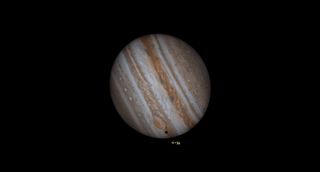
During the first week of May, bright, magnitude -2.0 Jupiter might be spotted within the twilight over the west-northwestern horizon after sunset. The young crescent moon will shine less than a palm's width above Jupiter on May 8.
The big planet will disappear while it passes solar conjunction on May 18 and then enter the morning sky. Jupiter will brush past Venus just before sunrise on May 23, but the giant planet won't return to visibility at mid-northern latitudes until June.
Saturn
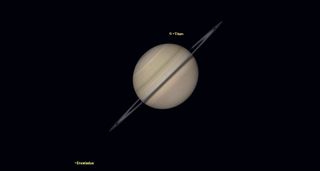
Like its ecliptic-neighbor Mars to its east, magnitude 1.18 Saturn will spend May in the eastern morning sky, shining among the stars of Aquarius. Its increasing angle from the pre-dawn sun will advance its rise time from 4 a.m. to 2 a.m. over the month, but the slanted ecliptic at mid-northern latitudes will hold the morning planets rather low in the sky. Yellow Saturn's separation from reddish Mars will increase from 14 to 34.4 degrees.
In a telescope, Saturn will sport a globe about 17 arc-seconds wide. Its rings, which will become edge-on to Earth next year, will already appear very narrow. Our edge-on views of the Saturn system this year and next will produce transits of Saturn's moons across its disk.
The old crescent moon will glide past Saturn on May 3-4 and again on May 31. Both passes will generate lunar occultations of Saturn.
Uranus

Uranus will begin May sitting close to Jupiter above the western horizon after sunset — but the distant planet will be too faint to see in the bright twilight. Uranus will pass the sun at solar conjunction on May 13 and then brush past Venus on May 18. Observers near the equator might begin to glimpse the planet above the east-northeastern horizon before sunrise at the very end of May.
Neptune
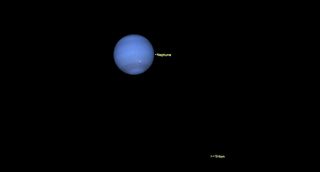
As May opens, the distant and faint, magnitude 7.9 planet Neptune will be observable in the eastern sky a thumb's width to the upper right (or 1.6 degrees to the celestial west) of far brighter Mars and surrounded by the stars of western Pisces.
Mars will race eastward away from Neptune while Saturn approaches it more slowly from the west. They'll be 11 degrees apart on May 31. Uranus will rise several hours before sunrise all month, allowing telescope users to see its tiny, 2.2 arc-second-wide blue disk.
The waning crescent moon will hop past Neptune on May 4-5. allowing skywatchers from southeastern Australia to New Zealand to watch the moon occult Neptune on May 5.
Skywatching terms
Gibbous: Used to describe a planet or moon that is more than 50% illuminated.
Asterism: A noteworthy or striking pattern of stars within a larger constellation.
Degrees (measuring the sky): The sky is 360 degrees all the way around, which means roughly 180 degrees from horizon to horizon. It's easy to measure distances between objects: Your fist on an outstretched arm covers about 10 degrees of sky, while a finger covers about one degree.
Visual Magnitude: This is the astronomer's scale for measuring the brightness of objects in the sky. The dimmest object visible in the night sky under perfectly dark conditions is about magnitude 6.5. Brighter stars are magnitude 2 or 1. The brightest objects get negative numbers. Venus can be as bright as magnitude minus 4.9. The full moon is minus 12.7 and the sun is minus 26.8.
Terminator: The boundary on the moon between sunlight and shadow.
Zenith: The point in the sky directly overhead.
Night sky observing tips
Adjust to the dark: If you wish to observe fainter objects, such as meteors, dim stars, nebulas, and galaxies, give your eyes at least 15 minutes to adjust to the darkness. Avoid looking at your phone's bright screen by keeping it tucked away. If you must use it, set the brightness to minimum — or cover it with clingy red film.
Light Pollution: Even from a big city, one can see the moon, a handful of bright stars, and the brightest planets - if they are above the horizon. But to fully enjoy the heavens — especially a meteor shower, the fainter constellations, or to see the amazing swath across the sky that is the disk of our home galaxy, the Milky Way — rural areas are best for night sky viewing. If you're stuck in a city or suburban area, use a tree or dark building to block ambient light (or moonlight) and help reveal fainter sky objects. If you're in the suburbs, simply turning off outdoor lights can help.
Prepare for skywatching: If you plan to be outside for more than a few minutes, and it's not a warm summer evening, dress more warmly than you think is necessary. An hour of winter observing can chill you to the bone. For meteor showers, a blanket or lounge chair will prove to be much more comfortable than standing, or sitting in a chair and craning your neck to see overhead.
Daytime skywatching: On the days surrounding first quarter, the moon is visible in the afternoon daytime sky. At last quarter, the moon rises before sunrise and lingers into the morning daytime sky. When Venus is at a significant angle away from the sun it can often be spotted during the day as a brilliant point of light - but you'll need to consult an astronomy app to know when and where to look for it. When large sunspots develop on the sun, they can be seen without a telescope — as long as you use proper solar filters, such as eclipse glasses. Permanent eye damage can occur if you look at the sun for any length of time without protective eyewear.
Join our Space Forums to keep talking space on the latest missions, night sky and more! And if you have a news tip, correction or comment, let us know at: community@space.com.
Get the Space.com Newsletter
Breaking space news, the latest updates on rocket launches, skywatching events and more!
Chris Vaughan, aka @astrogeoguy, is an award-winning astronomer and Earth scientist with Astrogeo.ca, based near Toronto, Canada. He is a member of the Royal Astronomical Society of Canada and hosts their Insider's Guide to the Galaxy webcasts on YouTube. An avid visual astronomer, Chris operates the historic 74˝ telescope at the David Dunlap Observatory. He frequently organizes local star parties and solar astronomy sessions, and regularly delivers presentations about astronomy and Earth and planetary science, to students and the public in his Digital Starlab portable planetarium. His weekly Astronomy Skylights blog at www.AstroGeo.ca is enjoyed by readers worldwide. He is a regular contributor to SkyNews magazine, writes the monthly Night Sky Calendar for Space.com in cooperation with Simulation Curriculum, the creators of Starry Night and SkySafari, and content for several popular astronomy apps. His book "110 Things to See with a Telescope", was released in 2021.
-
Malcolm Hi MMohammad,Reply
Thank you for your gracious welcome via email, though I fear we are ‘light years’ away from each other (as my comment shows, if it stays and is not censored) when it comes to this Earth and the Universe in which we live. I am no expert but each to their own beliefs.
Regards,
Malcolm -
Skyguy712 Reply
so much cap like if they don't exist then it's all most impossible for the universe to exist, i have a theory of the big bang, the white hole theory, i believe that a black hole had held gas and dust for millions of years and then it got older and older that it had died and spit up the dust and matter and gas and such, then it all collided making planets and suchcorey555 said:Black holes don't exist

